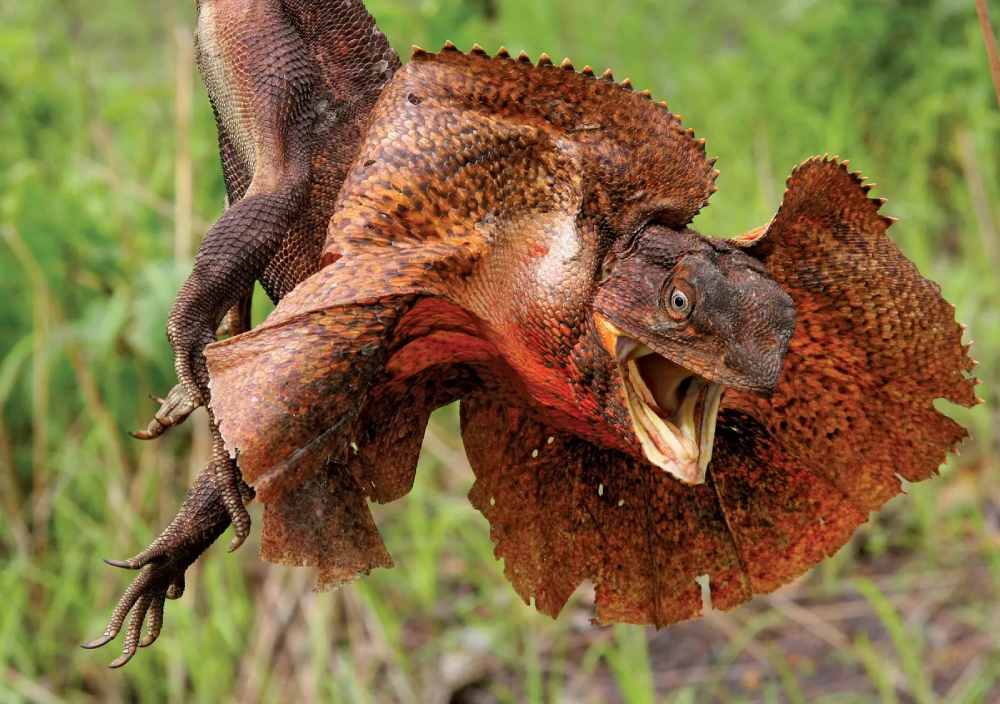The frilled lizard, scientifically known as *Chlamydosaurus kingii*, is one of nature’s most intriguing and visually striking reptiles. Native to Australia and New Guinea, these remarkable creatures have captivated the interest of scientists and animal enthusiasts alike with their unique physical characteristics, distinctive behaviors, and survival strategies. This article delves into the anatomy, habitat, behavior, diet, reproduction, and conservation status of the frilled lizard. We offer a comprehensive overview of this extraordinary species.
Anatomy and Physical Characteristics
The most distinctive feature of the frilled lizard is its prominent frill, a large, ruffled membrane of skin that encircles its neck. This frill, which can measure up to 30 centimeters in diameter when fully extended, is supported by long spines of cartilage connected to the jawbones. Typically, the frill remains folded back against the lizard’s body, but when threatened or agitated, the lizard fans it out to create an impressive display. This display is often accompanied by the lizard standing on its hind legs, hissing, and opening its mouth wide to reveal a bright pink or yellow oral cavity, all of which serve to intimidate potential predators.
Frilled lizards are relatively large compared to other lizard species, with adults typically reaching lengths of 70 to 90 centimeters, including their long tails. They exhibit a variety of color patterns, ranging from gray to reddish-brown, which provide excellent camouflage in their natural habitats. Their bodies are covered in small, keeled scales, and they have strong limbs with sharp claws that aid in climbing and digging.

Habitat and Distribution
Frilled lizards are primarily arboreal, spending a significant amount of time in trees. They inhabit dry forests, woodlands, and savannas, where they can find ample opportunities for basking, hunting, and evading predators. Their geographic range extends across northern Australia and into southern New Guinea. Within these regions, they prefer environments that offer both open spaces for hunting and dense vegetation for shelter and camouflage.
Behavior and Defense Mechanisms
The frilled lizard is diurnal, being most active during the day when it forages for food and basks in the sun to regulate its body temperature. Its behavior is characterized by a combination of cautious observation and rapid movement. When threatened, the frilled lizard’s first line of defense is to flee, typically seeking refuge in trees. If escape is not possible, it resorts to its iconic defensive display. By extending its frill, standing on its hind legs, and making itself appear larger and more formidable, the lizard aims to deter predators. This behavior is often enough to cause many would-be attackers to reconsider, as the display suggests that the lizard might be too challenging or risky to prey upon.
Diet and Hunting Techniques
Frilled lizards are insectivorous, primarily feeding on a variety of insects and other small invertebrates. Their diet includes ants, beetles, termites, spiders, and small vertebrates such as rodents and other lizards. They are opportunistic feeders, meaning they will consume whatever prey is readily available. The frilled lizard hunts using a combination of stealth and quick bursts of speed. It typically remains motionless, blending into its surroundings, until a prey item comes within striking distance. It then lunges forward with surprising speed, capturing its prey with its sharp teeth and powerful jaws.
Reproduction and Life Cycle
Frilled lizards are oviparous, laying eggs rather than giving birth to live young. The breeding season typically occurs during the wet season, when food is more abundant. Males establish and defend territories, engaging in displays and combat to attract females. Once a male successfully mates with a female, she will lay a clutch of 8-23 eggs in a shallow nest dug into the ground. The eggs incubate for about 2 to 3 months, depending on environmental conditions, before hatching. Hatchlings are independent from birth and receive no parental care. They must fend for themselves, finding food and avoiding predators from the moment they emerge from the eggs.
Conservation Status and Threats
Currently, the frilled lizard is not considered to be at significant risk of extinction. It is classified as a species of Least Concern by the International Union for Conservation of Nature (IUCN). However, like many wildlife species, frilled lizards face potential threats from habitat loss and fragmentation due to agricultural expansion, urban development, and climate change. In some areas, they may also be threatened by introduced predators such as domestic cats and dogs. Conservation efforts are focused on preserving natural habitats and ensuring that populations remain stable.
Cultural Significance and Popularity
The frilled lizard holds a special place in the cultural and natural heritage of Australia. It is featured in various Aboriginal art and mythology, symbolizing adaptation and survival. Additionally, the frilled lizard gained international fame in popular culture, notably appearing in the film Jurassic Park as the inspiration for the fictional Dilophosaurus’s frill and venom-spitting abilities. This portrayal, while not scientifically accurate, contributed to the frilled lizard’s popularity and recognition worldwide.
Conclusion
The frilled lizard is a remarkable example of evolutionary adaptation, showcasing how physical traits and behaviors can evolve to enhance survival in the wild. Its unique frill, striking displays, and arboreal lifestyle make it a subject of fascination and study. Understanding the frilled lizard’s ecology and behavior not only enriches our knowledge of biodiversity but also underscores the importance of conserving the natural habitats that support such extraordinary creatures. As we continue to explore and appreciate the diversity of life on Earth, the frilled lizard stands out as a symbol of nature’s ingenuity and resilience.









